Dog Tips - Summer
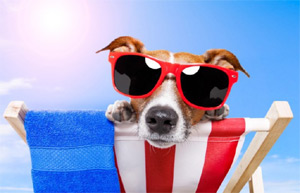 In warm and hot weather we must make sure that our dogs are happy, healthy and not suffering from the heat. This article covers dog walking, dehydration, heatstroke, summer pests, garden hazards, car travel and more.
In warm and hot weather we must make sure that our dogs are happy, healthy and not suffering from the heat. This article covers dog walking, dehydration, heatstroke, summer pests, garden hazards, car travel and more.
Drink
Make sure that your dog has a fresh bowl of water always available to them. They will drink more in the hot weather so you will need to check and re-fill it on a regular basis.
Feeding
Often your dog will seem less interested in food during the hot summer months. This is absolutely fine. We do it too, so try not to worry. Don't forget that your dog is probably doing less energetic running around or playing, so it should all equal out.
Treats
A great idea for a fun and cool summer treat for your dog is ice cubes (no, not ice-cream). Jazz it up a bit with a little low-salt chicken stock. You could even use a shallow bowl or cake tin to make a large ice 'cake' with their favourite balls and plastic toys inside the ice. Quite a cooling challenge. Or why not stuff a Kong and freeze it for a lasting summer treat.
Dehydration
Staying adequately hydrated is essential in preventing heat stroke. Dehydration can be a big problem in hot weather. It is important to keep your dog hydrated by providing adequate amounts of clean fresh water. Sounds simple but some dogs won't take kindly to drinking strange tasting water. Dogs prefer to drink what they are used to. If your pooch is particular to their local H2O, be sure to take plenty of water from home when going out and about.
Given a regular supply of water to drink, your dog should not dehydrate. However, it can happen.
One sign of dehydration is loss of skin elasticity. If you think your dog might be dehydrated, do this simple check. When the skin along the back is picked up into a fold, it should spring back into place. In dehydration, the skin stays up in a ridge. Another sign is dryness of the mouth. Late signs of dehydration are sunken eyes and circulatory collapse.
If your dog is dehydrated or very thirsty, do not let them gulp down excessive amounts of water all at once as they are likely to vomit it back up. Hydrate slowly. Give your dog an electrolyte mixed in water, which will be more effective than plain water at replenishing the body.
Walks
In the hot summer months it makes sense to walk your dog during the cooler part of the day. Walks in the morning or evening are much more comfortable and sensible for your dog than walks in the hot afternoon sun.
Always take water and a bowl with you on walks and offer it to your dog every 30 minutes or so. This will keep them hydrated and also guard against them dashing off to slurp from an alternative water source. We love the ingenious Snack-Duo Dog Water & Treat Bottle that can carry drink and treats in one bottle. Or how about the Lick n Flow water bottle that doesn't even need a bowl. So clever!
If your dog is normally very active on walks, playing fetch or running around, try to calm this down by playing less energetic games.
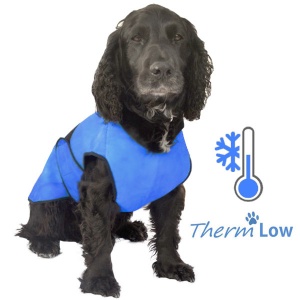 Keep your dog cool on walks and even indoors in a cool coat. We prefer a water activated one rather than the gel ones that can be bulky and heavy.
Keep your dog cool on walks and even indoors in a cool coat. We prefer a water activated one rather than the gel ones that can be bulky and heavy.
Our recommendation is the ThermLOW dog cooling coat. This handy little jacket just needs a quick soak in ordinary tap water and the simple evaporative process will keep your dog nice and cool - a bit like the equivalent of sweating, which dogs can't do naturally.
Watch out for summer picnickers. If your dog is prone to dashing off for a lick of someone's ice-cream then keep a tighter rein on them and don't allow them to cause a nuisance to other people during the walk. A picnicker has every right to be angry if your dog tramples their yummy spread.
In the Car
If you take your dog out in the car then bear in mind that it is hotter in the back than it is for you up in the front. Keep a careful eye on your dog and if the car is very hot or you will need to leave them in the car then don't take them with you.
Never leave your dog in the car on even just a slightly warm day. Leaving the window open a few inches for them, parking in the shade, or leaving them a bowl of water in the car is NOT adequate. A dog left in a car on a hot or even warm day can suffer heat stress and ultimately fatal heat stroke within just 10 minutes.
The temperature inside the car might not seem excessive when you first stop but the temperature inside a stationary car can rapidly increase to double the outside temperature - phew. This can happen very quickly, within six to ten minutes.
If you come across a dog that has been left in the car on a warm day, call the Police. They will be able to take appropriate action, if necessary breaking into the car to release the dog.
Conservatories
This is similar to leaving your dog in the car on a hot day. Never leave your dog in the conservatory when you go out. The same applies to greenhouses and any area that is likely to heat up in the summer sun.
Shade
Always make sure that your dog has access to a shady area to relax in and keep cool without the sun beating down on them. From little pop-up tents and cabanas to parasols, there are loads of great ways to provide shade for your best friend.
Heatstroke
Always bear in mind that your dog has a fur coat on that is designed to trap heat. Also, they cannot sweat to cool down and have to rely on panting to regulate their body temperature. Be particularly aware of vulnerable dogs such as short-nosed breeds, overweight dogs, youngsters and older dogs. These will all feel the heat more.
Learn to recognise the signs of heatstroke:
1) At first the dog will pant more than usual, become agitated and may seem uncomfortable or distressed.
2) Panting will become excessive and difficult and drooling may also start.
3) The dog will struggle to breathe and may appear glassy eyed and have dark red gums.
4) Body temperature has risen to a point where cell death in the brain results in seizures, coma and ultimately death. In these later stages, even with intensive veterinary care, your pet will probably die.
Dealing with heatstroke:
To deal with the early stages of overheating, move the dog to a cooler area and start cooling them down by covering them with a wet tea towel or similar. The quickest way to get a dog's temperature down is via their chest and paw pads, so concentrate your efforts on those areas. Don't use ice or very cold water as that can be a massive shock to the system.
If the dog has a seizure, don't restrain them, simply keep them surrounded by wet towels to cushion them and lessen risk of injury.
If you are out and about with your dog on a hot day, it can be a good idea to take some wet towels with you in a cool bag. But remember that prevention is better than cure. Don't put your dog in situations where heatstroke is likely to occur.
Keeping Cool
As mentioned, in warm and hot weather I always walk my dogs in a cool coat. They can prevent a dog from becoming overheated on summer walks or during strenuous activities and can also help cool down an already overheated animal. Great for use indoors and out. It is a summer essential.
Another recommended product for keeping your dog cool is a cool mat. It absorbs heat, reducing your dog's body temperature.
Most dogs adore splashing about in the water and it is a lovely cooling activity. To protect your dog from the sun, place the paddling pool in the shade or under a parasol or umbrella. Even in the pool the sun will still be hitting their head and back.
Sunburn & Paw Burn
Dogs love to sit in the sun but don't let them bake themselves. If necessary, restrict access to directly sunny areas and provide plenty of accessible shady places for them to relax.
Pets with light or white coats or exposed skin can get sun burnt. Use a sun block on exposed areas and on the tips of ears, forehead and nose or any area you feel could burn.
Don't walk your dog on hot surfaces such as pavements, tarmac, parking lots etc. as this can burn their pads. If it is too hot for the back of your hand, it is too hot for your dog's paws.
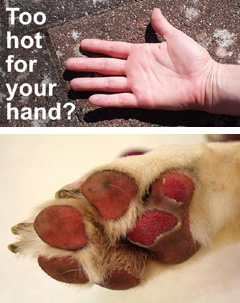
Walkies should be early in the morning or after the heat of the day has passed and hot walking surfaces have cooled. Walk on the grass where possible as that won't burn your dog's feet. If hot surfaces can't be avoided, buy your dog some comfortable and protective outdoor dog boots.
In the Garden
Everyone likes to spend time in the garden during the summer months, but make sure your garden is safe for your dog. The gardening season has many dangers for pets, with pellets, pesticides and other chemicals more likely to be in use. Before purchasing any chemicals for your garden and plants, read the labels carefully to make sure they are safe for pets. Even then, try to restrict access to areas of your garden where sprays, pellets and chemicals have been used. Better still, why not research more organic, friendly methods of dealing with garden pests.
Most dog owners now know about the dangers of giving chocolate to dogs (see Chocolate is Poisonous to Dogs) but don't forget that the same principal also applies to your garden mulch. Make sure you choose a safe, non-cocoa mulch.
The garden shed is another potential summer hazard. Make sure your dog cannot gain access. As you are likely to be going in and out of the shed more often during the summer, make sure you have placed dangerous products out of reach of your pet. For example, anti-freeze is highly toxic to cats and dogs and they are attracted to its sweet taste.
Make sure your dog is kept at a safe distance from BBQ cooking and also make sure your dog is safely indoors when you mow the lawn. Finally in garden hazards, it is worth checking that your dog cannot gain access to pools or garden ponds, or make sure they can at least get out again if they do fall in.
Many common household and garden plants and flowers can also be toxic to dogs, causing anything from skin irritations to severe poisoning and death. To find out more, visit our Poisonous to Dogs - Toxic Plants and Flowers article.
Coat
Imagine wearing a fur coat all summer. This is what your dog has to do. Consider getting them clipped shorter for the summer months so they are more comfortable (but not too short as that can have the opposite effect). Make sure your dog's coat is regularly groomed to remove any tangles, avoid matting of the coat and remove dead hair.
Ticks and Fleas
The warm weather brings out undesirable pests such as fleas, ticks and mites. Make sure you have a flea and tick procedure, whether you use natural remedies or off-the-shelf drops, collars and sprays. Find your preferred method and use it.
If your dog picks up a tick from walking in long grass or wooded areas, removal must be done correctly. Read our The Best Way to Remove a Dog Tick advice. An incorrectly removed tick can increase the likelihood of your dog catching a nasty disease.
The O'Tom Tick Twister hook is widely regarded to be the best and safest way to remove ticks without leaving the mouth parts of the tick planted in the skin. No use of chemicals. Quick and painless without squeezing the tick, thus reducing the risk of infection. This unique and ingenious tick removal device extracts the tick in less than five seconds. No compression of the ticks body and no risk of leaving mouth parts still attached, both of which may lead to the transfer of disease such as Babesia and Lyme disease.
Grass Seeds
Walks in long grass can give your dog more than a tick to worry about. Grass seeds can easily get caught in your dog’s paws, eyes or ears. After each walk check your dog’s feet for things stuck between the pads. If they have a foreign body in the eye it is likely to water and if it is in their ear they will probably shake their head a lot. These are delicate areas so your vet is the best person to deal with this kind of foreign body removal.
Wasp and Bee Stings
Most dogs love things that move fast and a bee or wasp is unfortunately seen by many dogs as being fun to chase and try to catch. If you see your dog chasing or attempting to play with a bee or wasp, distract and stop them.
If your dog does get stung then generally it is not an emergency situation and there are a number of things you can do. With a bee sting, remove the sting first with tweezers, taking care not to squeeze the poison sack, and then bathe the area in bicarbonate of soda (one desert spoon of bicarbonate of soda to one pint of water). With wasp stings there is no sting to remove so simply bathe the area, this time in malt vinegar or lemon juice. Bicarbonate of soda helps to neutralize the acid in a bee string as opposed to wasp stings, which are alkaline.
If your dog gets stung near the mouth or neck then medical attention may be required. Animals, like humans, can also be allergic or become allergic to stings. Watch out for any allergic reaction in your pet.
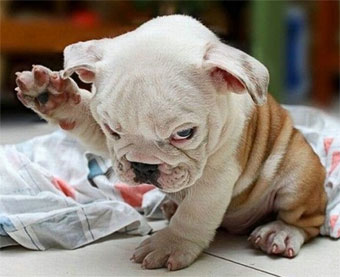 Hot and Bothered
Hot and Bothered
We can all feel a bit grumpy and agitated in the heat. Your dog is likely to feel this way too. Some dogs can be as irritable and bad-tempered as some humans when made uncomfortable by heat. Take this into account when you interact with your dog.
Even the most docile dog can get hot and bothered. Let your dog be and don’t allow children to poke or tease them, not that they should ever be allowed to do so anyway. Allow your dog some time away from all the excitement and activity that summer and the school holidays can bring.
Fun
It is summer so have some fun. On a hot day, water fun is often a welcome distraction and also a great way to cool down. Try your dog with the hose pipe for some fun and games. Take care with this. If your dog is anxious about the hose pipe then don’t force the issue. An alternative, as already mentioned, is a paddling pool. Bob some toys or treats in the water to gently coax your dog in, if they are nervous about water. Once dogs get the hang of water they soon learn that is it fun and cooling.
By Jenny Prevel
© D for Dog www.dfordog.co.uk
This article belongs strictly to D for Dog and we do not authorise the copying of all or any part of it.
Useful product links

.jpg)
.jpg)
.jpg)
.jpg)
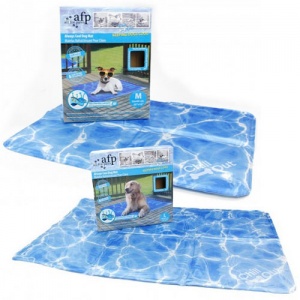




.jpg)
.jpg)
.jpg)

.jpg)
.jpg)
.jpg)
.jpg)
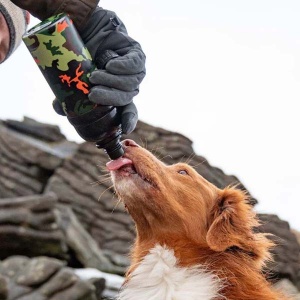

.jpg)
.jpg)
.jpg)
.jpg)
.jpg)
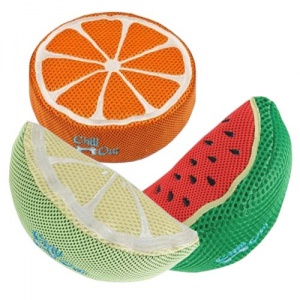
.jpg)
.jpg)
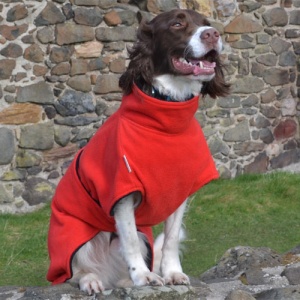
.jpg)
.jpg)
.jpg)
.jpg)

Any advice for owners of dogs who react to hot air balloons? There are lots where we live and work and my dog goes into a frenzy when he sees and hears them.
We have a dog like that, we usually shut the blinds down and turn up the radio until the balloon has gone over. It works for most of the time, if we see the balloon first before our dog does.
Try playing with or talking to your dog, giving him/her a treat or two, any positive attention. They will soon forget that the horrible noise is something they are scared of and relate it to positive things. I did this with my 2 and works a treat, good luck.
My dog isn't eat anything